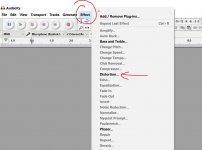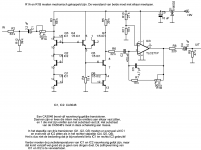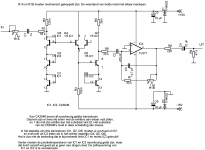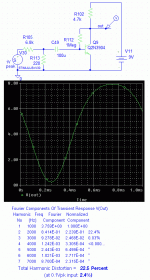Member
Joined 2009
Paid Member
I don't like op-amps because there's no fun in 'em. A passive option is to use a small transformer and add some dc-bias current through it to control where the signal sits on the BH curve - voila, adjustable 2nd harmonic distortion.
I tried in audacity, i couldn't find that specific "distortion" plugin, but i tried "diode processor" using half wave settings. To my ears, at low levels the distortion is not that bad, it's kind of bearable. At higher levels it just sounds distorted, and at full wave settings it is just unbearable.
I alse tried "harmonic generator" with similar results. Odd order harmonics just sound harsh and evil, even order harmonics are more bearable (especially low order, the higher you go in order, the worse it gets) but still sound distorted/bad.
I'm already wondering, who and why would prefer a slightly distorted signal over a nice and clean one? (except maybe guitar players)
Its installed by default although I am running the latest version after clean installing W10
Attachments
Is there a circuit that adds a nearly constant proportion of 2nd harmonic?
Supposedly a pure square-law device would do that (I think). But what would be the point, no audio amplifier acts like that? Their "percent distortion" as found in data sheets or ad literature is typically just some arbitrary % value they chose to define their "rated power" at. At low levels the distortion is very, very much lower. You can't practically find out what "playing at 5% distortion sounds like" (for total harmonic or any specific order) because with hifi amps that only happens at peaks of sinewaves, so it is more or less an undefined condition with music.
Badly designed class AB or B amps that have crossover distortion being the exception of course. With those % distortion can go up at lower levels. Those are pretty much extinct any more though.
Where's Wavebourne? 🙂. He built a distortion adder years ago and found that no one liked it their system.
I'm not too sure about this Euphonic/Euphoric distortion so many posters claim that "those people" like.
I'm not too sure about this Euphonic/Euphoric distortion so many posters claim that "those people" like.
Member
Joined 2009
Paid Member
I added distortion to a couple of my amps, didn't like it either so took it out. It was a big surprise for me that I actually like high feedback low distortion amps ! But for some music, a SET amp does wonders. Go figure.
Euphonic distortion is a nonsense, however it sometimes happens that people prefer a more distorted music file to original file in a blind test.
No-one seems to have mentioned the word translinear yet.
Taking advantage of the exponential characteristics of bipolar transistors and using loops of transistor BE-junctions, you can make just about any non-linear function you want to make. This is known as the translinear principle, and it was invented by Barrie Gilbert.
For example, the attached schematics should produce an x^1.5 type of distortion, just like the voltage to current characteristics of valves do according to Child's law (which no valve follows accurately, though). Mind you, I haven't tried either of these schematics. The left and right stacks of transistors must have equal numbers out of IC1 and equal numbers out of IC2. The CA3046 can be replaced with an LM3046, which is still available although it is also going out of production.
When you leave out Q2 and Q6 (and reduce R4 to 6.8 kohm in the 9 V version), it becomes a second-order distorting circuit. You then only need one LM3046 per channel.
R1A and R1B are supposed to be ganged potmeters. They are used for setting the level of distortion.
Taking advantage of the exponential characteristics of bipolar transistors and using loops of transistor BE-junctions, you can make just about any non-linear function you want to make. This is known as the translinear principle, and it was invented by Barrie Gilbert.
For example, the attached schematics should produce an x^1.5 type of distortion, just like the voltage to current characteristics of valves do according to Child's law (which no valve follows accurately, though). Mind you, I haven't tried either of these schematics. The left and right stacks of transistors must have equal numbers out of IC1 and equal numbers out of IC2. The CA3046 can be replaced with an LM3046, which is still available although it is also going out of production.
When you leave out Q2 and Q6 (and reduce R4 to 6.8 kohm in the 9 V version), it becomes a second-order distorting circuit. You then only need one LM3046 per channel.
R1A and R1B are supposed to be ganged potmeters. They are used for setting the level of distortion.
Attachments
Last edited:
But for some music, a SET amp does wonders. Go figure.
They do not in case you listen to complex classical orchestral music. They smear philharmonic music.
Taking advantage of the exponential characteristics of bipolar transistors and using loops of transistor BE-junctions,
It reminds me my diploma thesis almost 40 years ago, part of which was a multi-function converter with two LOG and two EXP amplifiers (BJT in opamp feedback). It was possible to wire it for pure quadratic transfer function.
Any particular kind or recordings?But for some music, a SET amp does wonders. Go figure.
Member
Joined 2009
Paid Member
The SET amp I made uses the non-linear 6AS7, doesn't put out much power and does nicely on Jazz, vocal in general. It can be used on anything at low volume but complex music at higher volume is less good - of course for a few years it was all I had. It was my first ever tube amp. Once I put in a DIY SS amp I realized where it's shortcomings were.
I have a JJ-2A3 tube with nice Sowter OT for a mono amp waiting to be built for half a decade already. And I have a plan to build a Shindo Claret preamp driving a Sindo Cortese amp which employs local feedback, having reverse engineered both of these designs - although I don't have the same specialized tubes it will still be a fun build based around a 6AV5 perhaps. One day. In the meantime, SS through and through.
I have a JJ-2A3 tube with nice Sowter OT for a mono amp waiting to be built for half a decade already. And I have a plan to build a Shindo Claret preamp driving a Sindo Cortese amp which employs local feedback, having reverse engineered both of these designs - although I don't have the same specialized tubes it will still be a fun build based around a 6AV5 perhaps. One day. In the meantime, SS through and through.
Last edited:
I wonder whether with relatively simple music, ie few instruments the predominantly second harmonic distortion isn't too bad and perhaps in the case of brass instruments with their odd harmonics can actually mellow their sound a bit
Member
Joined 2009
Paid Member
I think there are two aspects. A bit of 2nd order can mask higher orders, a decreasing set of harmonics. For a simple tube amp without feedback and simple music this seems to work well and the masking means it doesn't sound too distorted. However, put enough complex tones in there and it gets dominated by IM distortion which just ain't nice, it's all muddy. Purposely adding more 2nd harmonic to get some 'warmth' is a different thing, it's not with the aim of masking higher orders but I think you end up with the same limitation of IM products muddying things up. The problem is that most schemes for adding 2nd harmonics is volume-dependent, so louder and more complex music generates too much distortion. It tends to make bass sound flabby. A multi-amped system with clean signal on the bass and a bit of 2nd on the mids/treble might be a good compromise.
Bigun, yes that's exactly how the harmonic enhancer works, only frequencies above HPF are altered, usually around 3kHz.
Harmonic enhancers are standard in broadcasting on FM and TV.
One of the most popular is Aphex Aural Exciter, you can find it in almost every recording studio too.
In Audacity there is plugin for Harmonic Enhancer, nice to playing with and graphically see the effect.
Harmonic enhancers are standard in broadcasting on FM and TV.
One of the most popular is Aphex Aural Exciter, you can find it in almost every recording studio too.
In Audacity there is plugin for Harmonic Enhancer, nice to playing with and graphically see the effect.
What do you think about using 1 diode bypased by a resistor in series with the feedback resistor of the final amplifier?
2nd harmonic on an arbitrary wave is easily created with a simple BJT.
10K pots in and out would allow mixing this with the original source for any desired amount of 2nd.
Note that in ALL simple distortions, the % of distortion rises with signal level. None for very small signals, more for fairly large signals. 2nd rises nearly as level; 3rd rises faster.
10K pots in and out would allow mixing this with the original source for any desired amount of 2nd.
Note that in ALL simple distortions, the % of distortion rises with signal level. None for very small signals, more for fairly large signals. 2nd rises nearly as level; 3rd rises faster.
Attachments
I added distortion to a couple of my amps, didn't like it either so took it out. It was a big surprise for me that I actually like high feedback low distortion amps ! But for some music, a SET amp does wonders. Go figure.
I have to wonder how much of that might be due to the very low damping factor that SET amps typically have. Into most speakers, that will cause a bump at bass frequencies where impedance peaks, i.e., something like punching-in the loudness button on an older receiver. Also usually an upper mid frequency impedance bump will cause voices to be more prominent with a SET.
- Status
- Not open for further replies.
- Home
- Source & Line
- Analog Line Level
- How do i create second harmonic distortion?



